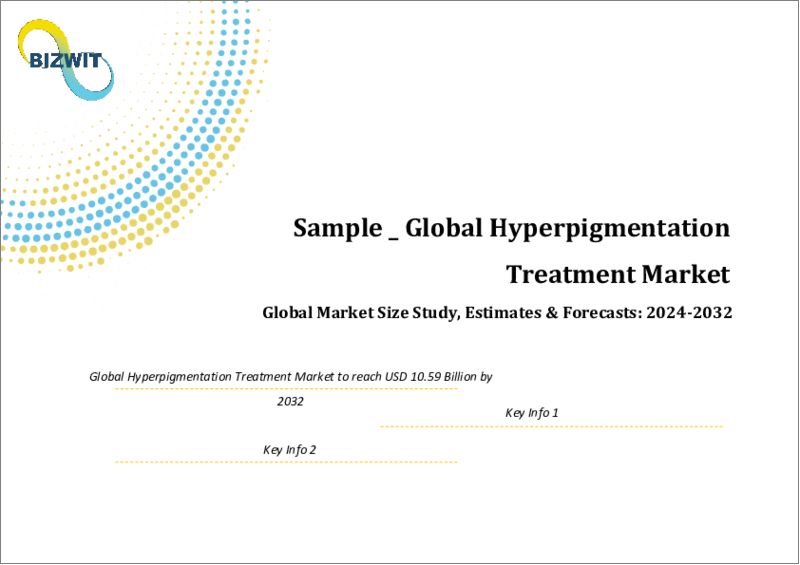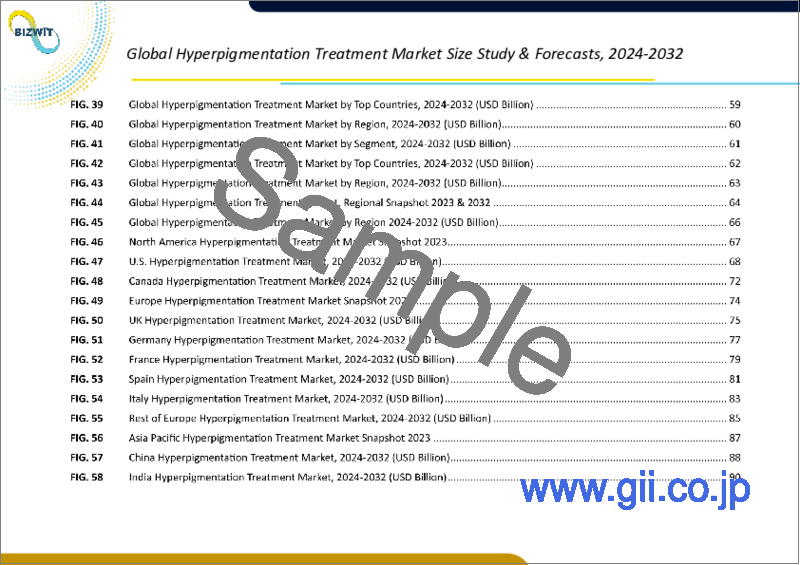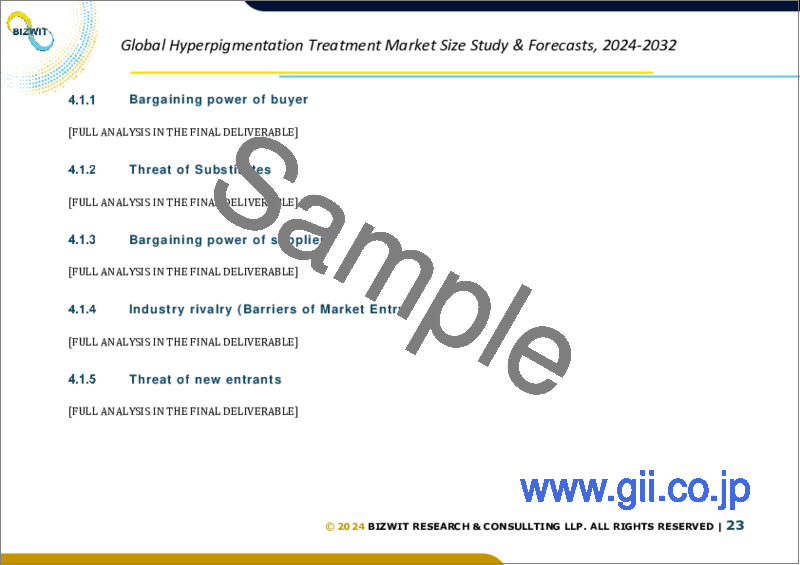|
|
市場調査レポート
商品コード
1517320
色素沈着治療の世界市場規模調査:治療タイプ別、疾患タイプ別、エンドユーザー別、地域別予測、2022-2032年Global Hyperpigmentation Treatment Market Size Study, by Treatment Type, by Disorder Type, by End User and Regional Forecasts 2022-2032 |
||||||
カスタマイズ可能
|
|||||||
| 色素沈着治療の世界市場規模調査:治療タイプ別、疾患タイプ別、エンドユーザー別、地域別予測、2022-2032年 |
|
出版日: 2024年07月15日
発行: Bizwit Research & Consulting LLP
ページ情報: 英文 200 Pages
納期: 2~3営業日
|
全表示
- 概要
- 目次
世界の色素沈着治療市場は、2023年に約54億8,000万米ドルと評価され、2024年から2032年までの予測期間においてCAGR 7.6%の堅調な成長が予測されています。
色素沈着とは、メラニンの過剰生産によって引き起こされる皮膚の黒化を指し、肝斑、炎症後色素沈着、黒点などの症状を引き起こします。色素沈着治療市場には、ハイドロキノン、レチノイド、植物エキスなどの成分を含む外用クリームから、高度なレーザー治療やケミカルピーリングまで、多様な製品と処置が含まれます。色素沈着治療製品の技術的進歩も市場成長の原動力となっています。ナノテクノロジーなどの技術革新は、皮膚への浸透性と生物学的利用能を向上させることで、一般的な色素沈着治療の有効性を高めています。例えば、ナノ粒子はメラニン産生細胞への有効成分の正確な送達を可能にし、より的を絞った効率的な治療アプローチを保証します。こうした進歩が、予測期間中の色素沈着治療市場の成長を促進するとみられます。
市場の成長は主に、スキンケアに対する意識の高まり、ソーシャルメディアが美容基準に与える影響の大きさ、製品の有効性を高める色素沈着治療製品の技術的進歩によってもたらされます。例えば、2022年に国立医学図書館が報告したように、新たな薬理学的治療薬には、肝斑や炎症後色素沈着を治療するための局所メトホルミン、フルタミド、イソブチルアミドチアゾリルレゾルシノール、多血小板血漿が含まれます。さらに、世界保健機関(WHO)によると2050年までに21億人に達すると予想される老人人口の増加も、色素沈着などの皮膚科学的懸念に対する高齢者の感受性の高まりのため、市場成長の原動力となっています。スキンケアに対する意識の高まりと、美の基準に対するソーシャルメディアの影響により、色素沈着治療製品に対する需要が大幅に増加しています。消費者は、濃いシミを薄くし、肌のトーンを均一にし、輝きを取り戻すことを約束する、局所クリーム、美容液、ケミカルピーリング、レーザー治療などの革新的な解決策をますます求めるようになっています。専門的な治療を提供するスキンケアブランドやクリニックの拡大が、市場の成長にさらに貢献しています。
世界の色素沈着治療市場の調査対象となった主な地域は、北米、欧州、アジア太平洋、ラテンアメリカ、中東・アフリカです。北米は2023年に大きな市場シェアを占めました。この成長の原動力は、スキンケア技術の進歩、美容施術に対する認識と受容の高まり、効果的で安全な治療オプションに対する需要の高まりです。人口の高齢化、肝斑や炎症後色素沈着を含む皮膚疾患の罹患率の上昇、皮膚科治療の進歩などの治療要因が市場成長に寄与しています。さらに、北米の色素沈着治療市場では、大手製薬会社、スキンケアブランド、皮膚科クリニックが重要な役割を果たしています。さらに、アジア太平洋地域は予測期間2024年から2032年にかけて最も高い成長率を示すと予測されています。
目次
第1章 色素沈着治療の世界市場:エグゼクティブサマリー
- 色素沈着治療の世界市場規模・予測(2022-2032年)
- 地域別概要
- セグメント別概要
- 治療タイプ別
- 疾患タイプ別
- エンドユーザー別
- 主要動向
- 景気後退の影響
- アナリストの結論・提言
第2章 世界の色素沈着治療市場の定義と調査前提条件
- 調査目的
- 市場の定義
- 調査前提条件
- 包含と除外
- 制限事項
- 供給サイドの分析
- 入手可能性
- インフラ
- 規制環境
- 市場競争
- 経済性(消費者の視点)
- 需要サイド分析
- 規制の枠組み
- 技術の進歩
- 環境への配慮
- 消費者の意識と受容
- 調査手法
- 調査対象年
- 通貨換算レート
第3章 世界の色素沈着治療市場力学
- 市場促進要因
- スキンケアに対する意識の高まり
- ソーシャルメディアが美の基準に与える影響の高さ
- 治療製品の技術的進歩
- 市場の課題
- 原材料価格の変動
- 高度な治療法のコスト高
- 市場機会
- 老人人口の増加
- 製品処方と送達方法の革新
第4章 世界の色素沈着治療市場:産業分析
- ポーターのファイブフォースモデル
- 供給企業の交渉力
- 買い手の交渉力
- 新規参入業者の脅威
- 代替品の脅威
- 競争企業間の敵対関係
- ポーターのファイブフォースモデルへの未来的アプローチ
- ポーターのファイブフォースの影響分析
- PESTEL分析
- 政治
- 経済
- 社会
- 技術
- 環境
- 法律
- 主な投資機会
- 主要成功戦略
- 破壊的動向
- 業界専門家の視点
- アナリストの結論・提言
第5章 色素沈着治療の世界市場規模・予測:治療タイプ別、2022年~2032年
- セグメントダッシュボード
- 色素沈着治療の世界市場:治療タイプ別、収益動向分析、2022年・2032年
- 局所薬
- 光治療
- マイクロダーマブレーション
第6章 色素沈着治療の世界市場規模・予測:疾患タイプ別、2022年~2032年
- セグメントダッシュボード
- 色素沈着治療の世界市場:疾患タイプ別、収益動向分析、2022年・2032年
- シミ
- 肝斑
- その他
第7章 色素沈着治療の世界市場規模・予測:エンドユーザー別、2022年~2032年
- セグメントダッシュボード
- 色素沈着治療の世界市場:エンドユーザー別、収益動向分析、2022年・2032年
- 病院
- 皮膚科クリニック
- その他
第8章 色素沈着治療の世界市場規模・予測:地域別、2022年~2032年
- 北米の色素沈着治療市場
- 米国の色素沈着治療市場
- カナダの色素沈着治療市場
- 欧州の色素沈着治療市場
- ドイツの色素沈着治療市場
- 英国の色素沈着治療市場
- フランスの色素沈着治療市場
- イタリアの色素沈着治療市場
- その他欧州の色素沈着治療市場
- アジア太平洋の色素沈着治療市場
- 中国の色素沈着治療市場
- インドの色素沈着治療市場
- 日本の色素沈着治療市場
- 韓国の色素沈着治療市場
- その他アジア太平洋の色素沈着治療市場
- ラテンアメリカの色素沈着治療市場
- ブラジルの色素沈着治療市場
- メキシコの色素沈着治療市場
- その他ラテンアメリカの色素沈着治療市場
- 中東・アフリカの色素沈着治療市場
- サウジアラビアの色素沈着治療市場
- 南アフリカの色素沈着治療市場
- その他中東・アフリカの色素沈着治療市場
第9章 競合情報
- 主要企業のSWOT分析
- 主要市場戦略
- 企業プロファイル
- Pierre Fabre S.A.
- 主要情報
- 概要
- 財務(データの入手可能性によります)
- 製品概要
- 市場戦略
- Areolase Corporation
- Candela Corporation
- SkinBase
- EpiPharm AG
- Galderma S.A.
- Alchemee LLC
- Allergan Aesthetics
- AMBI Skincare
- Procter & Gamble
- Unilever
- Johnson & Johnson
- Episciences Inc.
- Vivier Pharma
- L'Oreal Group
- Pierre Fabre S.A.
第10章 調査プロセス
The Global Hyperpigmentation Treatment Market was valued at approximately USD 5.48 billion in 2023 and is projected to grow at a robust CAGR of 7.6% over the forecast period from 2024 to 2032. Hyperpigmentation refers to the darkening of the skin caused by the overproduction of melanin, leading to conditions such as melasma, post-inflammatory hyperpigmentation, and sunspots. The market for hyperpigmentation treatment includes a diverse range of products and procedures, ranging from topical creams containing ingredients such as hydroquinone, retinoids, and botanical extracts to advanced laser therapies and chemical peels. Technological advancements in hyperpigmentation treatment products are also driving market growth. Innovations such as nanotechnology are enhancing the efficacy of common hyperpigmentation active ingredients by improving their skin penetration and bioavailability. For instance, nanoparticles enable the precise delivery of active ingredients to melanin-producing cells, ensuring a more targeted and efficient therapeutic approach. These advancements are expected to drive the hyperpigmentation treatment market growth over the forecast period.
The market's growth is primarily driven by an increasing awareness about skincare, the high impact of social media on beauty standards, and technological advancements in hyperpigmentation treatment products that enhance product effectiveness. For instance, emerging pharmacological therapeutics include topical metformin, flutamide, isobutylamido thiazolyl resorcinol, and platelet-rich plasma for treating melasma and post-inflammatory hyperpigmentation, as reported by the National Library of Medicine in 2022. Additionally, the rising geriatric population, expected to reach 2.1 billion by 2050 according to the World Health Organization, is also driving market growth due to the increased susceptibility of older individuals to dermatological concerns such as hyperpigmentation. The growing awareness about skincare and the influence of social media on beauty standards have significantly increased the demand for hyperpigmentation treatment products. Consumers are increasingly seeking out innovative solutions, such as topical creams, serums, chemical peels, and laser therapies, that promise to fade dark spots, even skin tone, and restore radiance. The expanding range of skincare brands and clinics offering specialized treatments has further contributed to the market's growth.
The key regions considered for the Global Hyperpigmentation Treatment Market study include North America, Europe, Asia Pacific, Latin America, and the Middle East and Africa. North America accounted for a significant market share in 2023. This growth is driven by advancements in skincare technology, increasing awareness and acceptance of cosmetic procedures, and rising demand for effective and safe treatment options. Factors such as an aging population, rising incidences of skin disorders, including melasma and post-inflammatory hyperpigmentation, and advancements in dermatological treatments contribute to market growth. Moreover, Major pharmaceutical companies, skincare brands, and dermatology clinics play significant roles in the North America hyperpigmentation treatment market. Furthermore, The Asia-Pacific region is projected to experience the highest growth rate during the forecast period 2024-2032.
Major market players included in this report are:
- Episciences Inc.
- Vivier Pharma
- Pierre Fabre S.A
- L'Oreal Group
- Areolase Corporation
- Candela Corporation
- SkinBase
- EpiPharm AG
- Galderma S.A.
- Alchemee LLC
- Allergan Aesthetics
- AMBI Skincare
- Procter & Gamble
- Unilever
- Johnson & Johnson
The detailed segments and sub-segments of the market are explained below:
By Treatment Type:
- Topical Agent
- Photo Therapy
- Microdermabrasion
By Disorder Type:
- Age Spot
- Melasma
- Other
By End User:
- Hospitals
- Dermatological Clinics
- Others
By Region:
- North America
- U.S.
- Canada
- Europe
- UK
- Germany
- France
- Spain
- Italy
- ROE
- Asia Pacific
- China
- India
- Japan
- Australia
- South Korea
- RoAPAC
- Latin America
- Brazil
- Mexico
- Rest of Latin America
- Middle East & Africa
- Saudi Arabia
- South Africa
- RoMEA
Years considered for the study are as follows:
- Historical year - 2022
- Base year - 2023
- Forecast period - 2024 to 2032
Key Takeaways:
- Market Estimates & Forecast for 10 years from 2022 to 2032.
- Annualized revenues and regional level analysis for each market segment.
- Detailed analysis of geographical landscape with Country level analysis of major regions.
- Competitive landscape with information on major players in the market.
- Analysis of key business strategies and recommendations on future market approach.
- Analysis of competitive structure of the market.
- Demand side and supply side analysis of the market.
Table of Contents
Chapter 1. Global Hyperpigmentation Treatment Market Executive Summary
- 1.1. Global Hyperpigmentation Treatment Market Size & Forecast (2022-2032)
- 1.2. Regional Summary
- 1.3. Segmental Summary
- 1.3.1. By Treatment Type
- 1.3.2. By Disorder Type
- 1.3.3. By End User
- 1.4. Key Trends
- 1.5. Recession Impact
- 1.6. Analyst Recommendation & Conclusion
Chapter 2. Global Hyperpigmentation Treatment Market Definition and Research Assumptions
- 2.1. Research Objective
- 2.2. Market Definition
- 2.3. Research Assumptions
- 2.3.1. Inclusion & Exclusion
- 2.3.2. Limitations
- 2.3.3. Supply Side Analysis
- 2.3.3.1. Availability
- 2.3.3.2. Infrastructure
- 2.3.3.3. Regulatory Environment
- 2.3.3.4. Market Competition
- 2.3.3.5. Economic Viability (Consumer's Perspective)
- 2.3.4. Demand Side Analysis
- 2.3.4.1. Regulatory frameworks
- 2.3.4.2. Technological Advancements
- 2.3.4.3. Environmental Considerations
- 2.3.4.4. Consumer Awareness & Acceptance
- 2.4. Estimation Methodology
- 2.5. Years Considered for the Study
- 2.6. Currency Conversion Rates
Chapter 3. Global Hyperpigmentation Treatment Market Dynamics
- 3.1. Market Drivers
- 3.1.1. Increasing awareness about skincare
- 3.1.2. High impact of social media on beauty standards
- 3.1.3. Technological advancements in treatment products
- 3.2. Market Challenges
- 3.2.1. Fluctuation in raw material prices
- 3.2.2. High cost of advanced treatment procedures
- 3.3. Market Opportunities
- 3.3.1. Rise in geriatric population
- 3.3.2. Innovations in product formulations and delivery methods
Chapter 4. Global Hyperpigmentation Treatment Market Industry Analysis
- 4.1. Porter's 5 Force Model
- 4.1.1. Bargaining Power of Suppliers
- 4.1.2. Bargaining Power of Buyers
- 4.1.3. Threat of New Entrants
- 4.1.4. Threat of Substitutes
- 4.1.5. Competitive Rivalry
- 4.1.6. Futuristic Approach to Porter's 5 Force Model
- 4.1.7. Porter's 5 Force Impact Analysis
- 4.2. PESTEL Analysis
- 4.2.1. Political
- 4.2.2. Economical
- 4.2.3. Social
- 4.2.4. Technological
- 4.2.5. Environmental
- 4.2.6. Legal
- 4.3. Top investment opportunity
- 4.4. Top winning strategies
- 4.5. Disruptive Trends
- 4.6. Industry Expert Perspective
- 4.7. Analyst Recommendation & Conclusion
Chapter 5. Global Hyperpigmentation Treatment Market Size & Forecasts by Treatment Type 2022-2032
- 5.1. Segment Dashboard
- 5.2. Global Hyperpigmentation Treatment Market: Treatment Type Revenue Trend Analysis, 2022 & 2032 (USD Billion)
- 5.2.1. Topical Agent
- 5.2.2. Photo Therapy
- 5.2.3. Microdermabrasion
Chapter 6. Global Hyperpigmentation Treatment Market Size & Forecasts by Disorder Type 2022-2032
- 6.1. Segment Dashboard
- 6.2. Global Hyperpigmentation Treatment Market: Disorder Type Revenue Trend Analysis, 2022 & 2032 (USD Billion)
- 6.2.1. Age Spot
- 6.2.2. Melasma
- 6.2.3. Other
Chapter 7. Global Hyperpigmentation Treatment Market Size & Forecasts by End User 2022-2032
- 7.1. Segment Dashboard
- 7.2. Global Hyperpigmentation Treatment Market: End User Revenue Trend Analysis, 2022 & 2032 (USD Billion)
- 7.2.1. Hospitals
- 7.2.2. Dermatological Clinics
- 7.2.3. Others
Chapter 8. Global Hyperpigmentation Treatment Market Size & Forecasts by Region 2022-2032
- 8.1. North America Hyperpigmentation Treatment Market
- 8.1.1. U.S. Hyperpigmentation Treatment Market
- 8.1.1.1. Treatment Type breakdown size & forecasts, 2022-2032
- 8.1.1.2. Disorder Type breakdown size & forecasts, 2022-2032
- 8.1.1.3. End User breakdown size & forecasts, 2022-2032
- 8.1.2. Canada Hyperpigmentation Treatment Market
- 8.1.2.1. Treatment Type breakdown size & forecasts, 2022-2032
- 8.1.2.2. Disorder Type breakdown size & forecasts, 2022-2032
- 8.1.2.3. End User breakdown size & forecasts, 2022-2032
- 8.1.1. U.S. Hyperpigmentation Treatment Market
- 8.2. Europe Hyperpigmentation Treatment Market
- 8.2.1. Germany Hyperpigmentation Treatment Market
- 8.2.2. UK Hyperpigmentation Treatment Market
- 8.2.3. France Hyperpigmentation Treatment Market
- 8.2.4. Italy Hyperpigmentation Treatment Market
- 8.2.5. Rest of Europe Hyperpigmentation Treatment Market
- 8.3. Asia-Pacific Hyperpigmentation Treatment Market
- 8.3.1. China Hyperpigmentation Treatment Market
- 8.3.2. India Hyperpigmentation Treatment Market
- 8.3.3. Japan Hyperpigmentation Treatment Market
- 8.3.4. South Korea Hyperpigmentation Treatment Market
- 8.3.5. Rest of Asia-Pacific Hyperpigmentation Treatment Market
- 8.4. Latin America Hyperpigmentation Treatment Market
- 8.4.1. Brazil Hyperpigmentation Treatment Market
- 8.4.2. Mexico Hyperpigmentation Treatment Market
- 8.4.3. Rest of Latin America Hyperpigmentation Treatment Market
- 8.5. Middle East & Africa Hyperpigmentation Treatment Market
- 8.5.1. Saudi Arabia Hyperpigmentation Treatment Market
- 8.5.2. South Africa Hyperpigmentation Treatment Market
- 8.5.3. Rest of MEA Hyperpigmentation Treatment Market
Chapter 9. Competitive Intelligence
- 9.1. Key Company SWOT Analysis
- 9.2. Top Market Strategies
- 9.3. Company Profiles
- 9.3.1. Pierre Fabre S.A.
- 9.3.1.1. Key Information
- 9.3.1.2. Overview
- 9.3.1.3. Financial (Subject to Data Availability)
- 9.3.1.4. Product Summary
- 9.3.1.5. Market Strategies
- 9.3.2. Areolase Corporation
- 9.3.3. Candela Corporation
- 9.3.4. SkinBase
- 9.3.5. EpiPharm AG
- 9.3.6. Galderma S.A.
- 9.3.7. Alchemee LLC
- 9.3.8. Allergan Aesthetics
- 9.3.9. AMBI Skincare
- 9.3.10. Procter & Gamble
- 9.3.11. Unilever
- 9.3.12. Johnson & Johnson
- 9.3.13. Episciences Inc.
- 9.3.14. Vivier Pharma
- 9.3.15. L'Oreal Group
- 9.3.1. Pierre Fabre S.A.
Chapter 10. Research Process
- 10.1. Research Process
- 10.1.1. Data Mining
- 10.1.2. Analysis
- 10.1.3. Market Estimation
- 10.1.4. Validation
- 10.1.5. Publishing
- 10.2. Research Attributes






